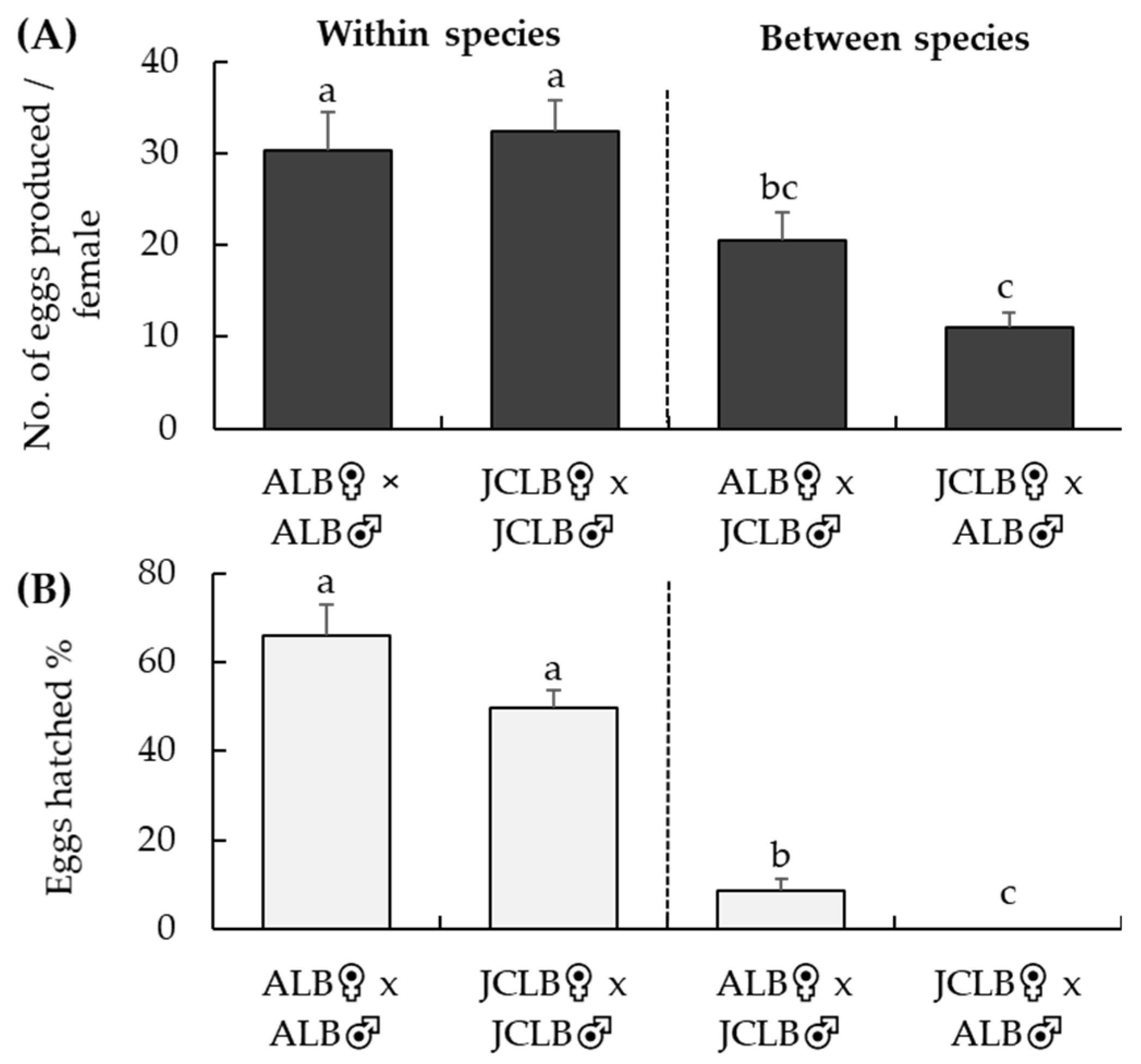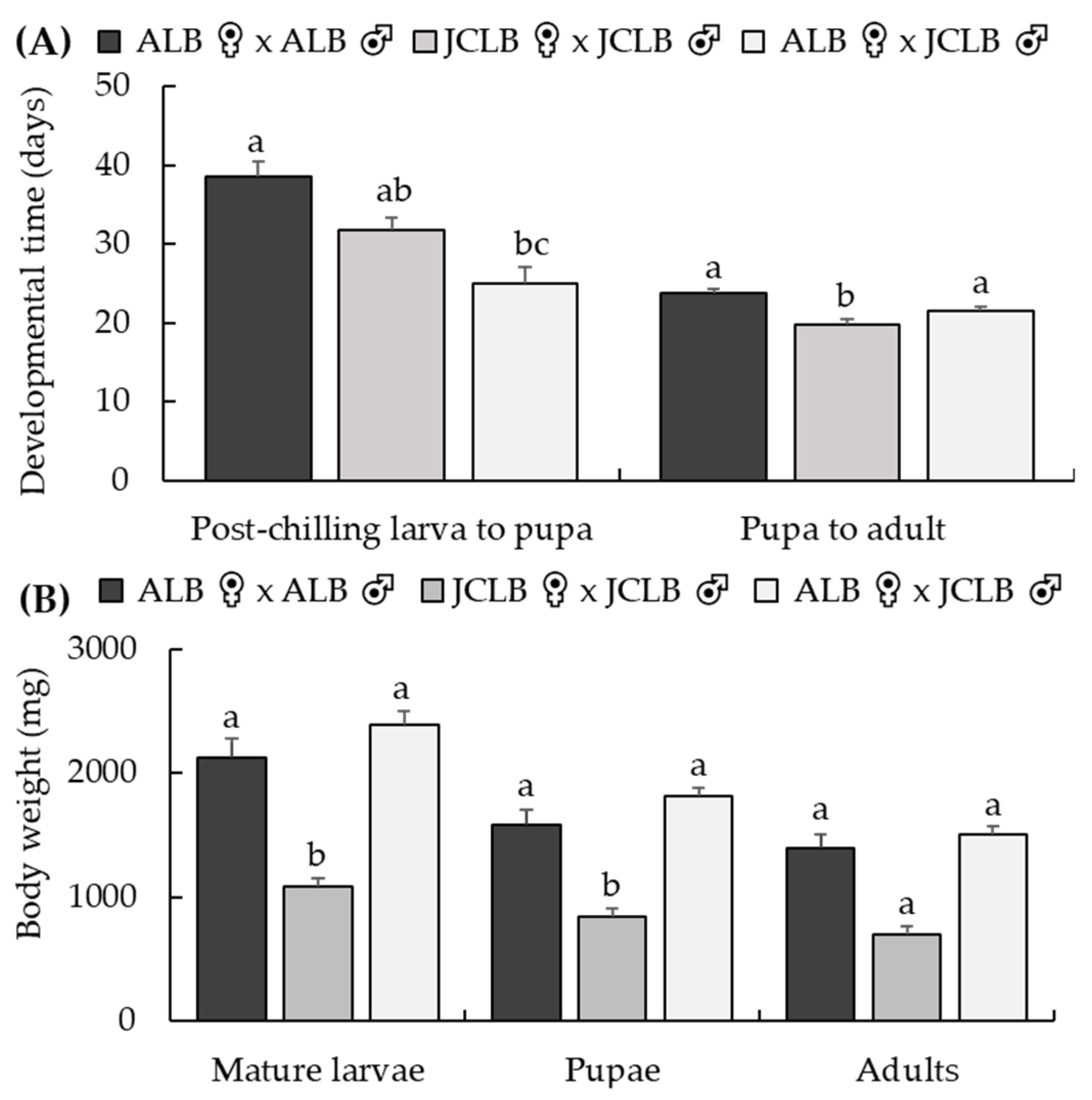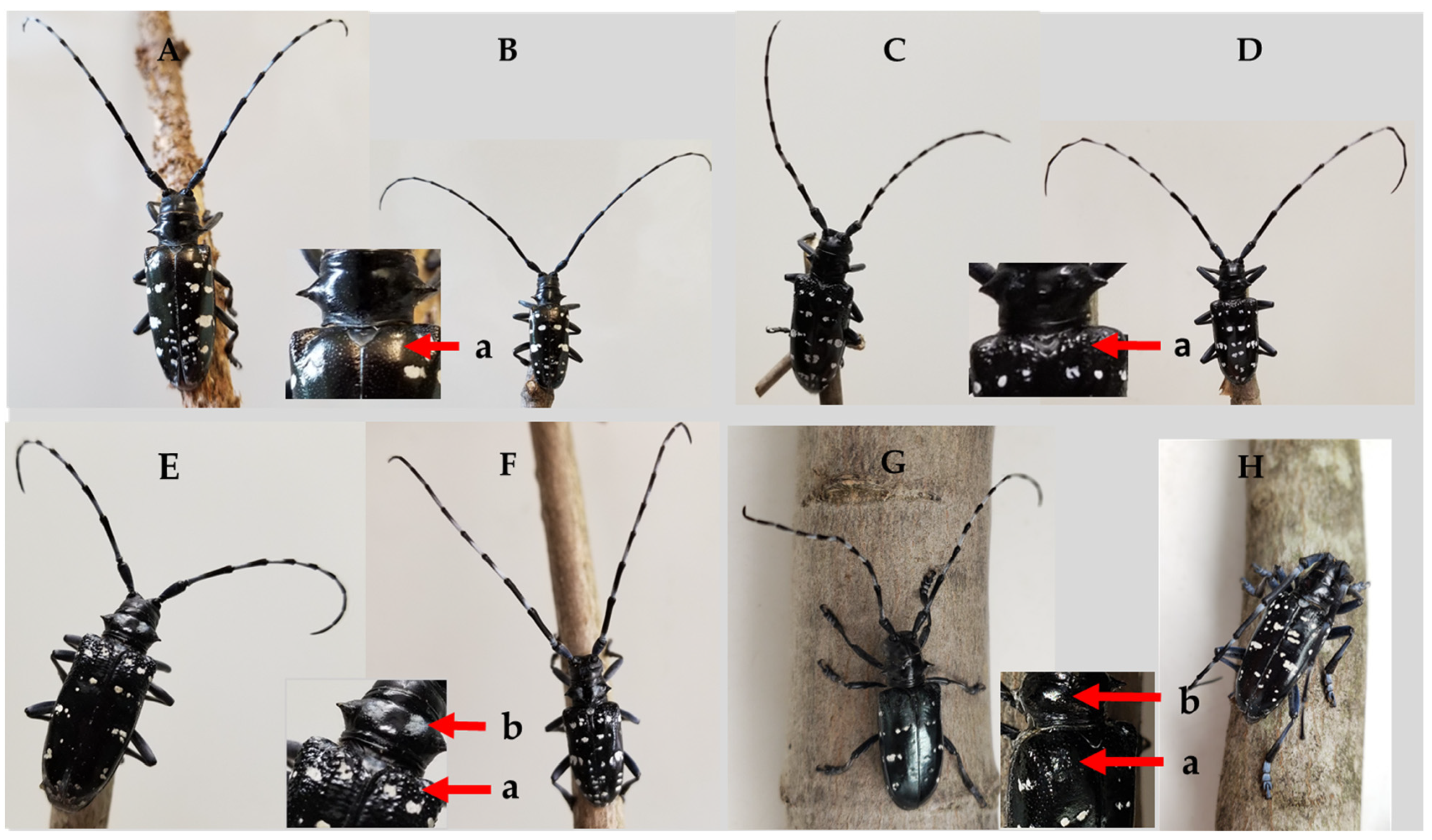Hybridization Potential of Two Invasive Asian Longhorn Beetles
Abstract
:Simple Summary
Abstract
1. Introduction
2. Materials and Methods
2.1. Insects
2.2. Crossing Bioassays at BIIRU
2.3. Crossing Bioassays at NRSQL
2.4. Data Analyses
3. Results
3.1. Crossing Bioassays at BIIRU
3.2. Crossing Bioassays at NRSQL
4. Discussion
Author Contributions
Funding
Institutional Review Board Statement
Informed Consent Statement
Data Availability Statement
Acknowledgments
Conflicts of Interest
References
- Arnold, M.L. Natural Hybridization and Evolution; Oxford University Press: New York, NY, USA, 1997. [Google Scholar]
- Coyne, J.A.; Orr, H.A. Patterns of speciation in Drosophila revisited. Evolution 1997, 51, 295–303. [Google Scholar] [PubMed]
- Hopper, K.R.; Britch, S.C.; Wajnberg, E. Risks of interbreeding between species used in biological control and native species, and methods for evaluating their occurrence and impact. In Environmental Impact of Invertebrates for Biological Control of Arthropods: Methods and Risk Assessment; Bigler, F., Babendreier, D., Kuhlmann, U., Eds.; CAB International: Delemont, Switzerland, 2006; pp. 78–97. [Google Scholar]
- Mallet, J. Hybridization as an invasion of the genome. Trends Ecol. Evol. 2005, 20, 229–237. [Google Scholar] [CrossRef] [PubMed]
- Abbott, R.; Albach, D.; Ansell, S.; Arntzen, J.W.; Baird, S.J.E.; Bierne, N.; Boughman, J.; Brelsford, A.; Buerkle, C.A.; Buggs, R.; et al. Hybridization and speciation. J. Evol. Biol. 2013, 26, 229–246. [Google Scholar] [CrossRef] [PubMed] [Green Version]
- Abbott, R.J.; Barton, N.H.; Good, J.M. Genomics of hybridization and its evolutionary consequences. Mol. Ecol. 2016, 25, 2325–2332. [Google Scholar] [CrossRef] [PubMed] [Green Version]
- Corrêa, A.S.; Cordeiro, E.M.G.; Omoto, C. Agricultural insect hybridization and implications for pest management. Pest Manage. Sci. 2019, 75, 2857–2864. [Google Scholar] [CrossRef]
- Anderson, C.J.; Oakeshott, J.G.; Tay, W.T.; Gordon, K.H.J.; Zwick, A.; Walsh, T.K. Hybridization and gene flow in the mega-pest lineage of moth, Helicoverpa. Proc. Natl. Acad. Sci. USA 2018, 115, 5034–5039. [Google Scholar] [CrossRef] [Green Version]
- Clarke, K.E.; Rinderer, T.E.; Franck, P.; Quezada-Euán, J.G.; Oldroyd, B.P. The Africanization of honeybees (Apis mellifera L.) of the Yucatan: A study of a massive hybridization event across time. Evolution 2002, 56, 1462–1474. [Google Scholar] [CrossRef]
- Haack, R.A.; Hérard, F.; Sun, J.; Turgeon, J.J. Managing invasive populations of Asian longhorned beetle and citrus longhorned beetle: A worldwide perspective. Annu. Rev. Entomol. 2010, 55, 521–546. [Google Scholar] [CrossRef] [PubMed] [Green Version]
- Lingafelter, S.W.; Hoebeke, E.R. Revision of Anoplophora (Coleoptera: Cerambycidae); Entomological Society of Washington: Washington, DC, USA, 2002; p. 236. [Google Scholar]
- Lee, S.; Lee, Y.; Lee, S. Population genetic structure of Anoplophora glabripennis in South Korea: Invasive populations in the native range? J. Pest Sci. 2021, 93, 1181–1196. [Google Scholar] [CrossRef]
- Animal and Plant Health Inspection Service (APHIS). Asian Longhorned Beetle—Quarantines. Available online: https://www.aphis.usda.gov/aphis/resources/pests-diseases/asian-longhorned-beetle (accessed on 10 December 2021).
- Branco, S.; Faccoli, M.; Brockerhoff, E.G.; Roux, G.; Jactel, H.; Desneux, N.; Gachet, E.; Mouttet, R.; Streito, J.-C.; Branco, M. Preventing invasions of Asian longhorn beetle and citrus longhorn beetle: Are we on the right track? J. Pest. Sci. 2021, 1–26. [Google Scholar] [CrossRef]
- Coyle, D.R.; Trotter, R.T.; Bean, M.S.; Pfister, S.E. First recorded Asian longhorned beetle (Coleoptera: Cerambycidae) infestation in the Southern United States. J. Integrat. Pest Manag. 2021, 12, 10. [Google Scholar] [CrossRef]
- European and Mediterranean Plant Protection Organization (EPPO). EPPO Alert List. Available online: http://archives.eppo.int/EPPOReporting/Reporting_Archives.htm (accessed on 10 December 2021).
- Carter, M.; Smith, M.; Harrison, R. Genetic analyses of the Asian longhorned beetle (Coleoptera, Cerambycidae, Anoplophora glabripennis), in North America, Europe and Asia. Biol. Invasions 2010, 12, 1165–1182. [Google Scholar] [CrossRef]
- Javal, M.; Roques, A.; Haran, J.; Hérard, F.; Keena, M.; Roux, G. Complex invasion history of the Asian long-horned beetle: Fifteen years after first detection in Europe. J. Pest Sci. 2019, 92, 173–187. [Google Scholar] [CrossRef]
- Javal, M.; Lombaert, E.; Tsykun, T.; Courtin, C.; Kerdelhué, C.; Prospero, S.; Roques, A.; Roux, G. Deciphering the worldwide invasion of the Asian long-horned beetle: A recurrent invasion process from the native area together with a bridgehead effect. Mol. Ecol. 2019, 28, 951–967. [Google Scholar] [CrossRef]
- Tsykun, T.; Javal, M.; Holling, D.; Roux, G.; Prospero, S. Fine-scale invasion genetics of the quarantine pest, Anoplophora glabripennis, reconstructed in single outbreaks. Sci. Rep. 2019, 9, 19436. [Google Scholar] [CrossRef]
- MacLeoda, A.; Evansb, H.F.; Baker, R.H.A. An analysis of pest risk from an Asian longhorn beetle (Anoplophora glabripennis) to hardwood trees in the European community. Crop Prot. 2002, 21, 635–645. [Google Scholar] [CrossRef]
- Ge, X.Z.; Zong, S.X.; He, S.Y.; Liu, Y.T.; Kong, X.Q. Areas of China predicted to have a suitable climate for Anoplophora chinensis under a climate-warming scenario. Entomol. Exp. Appl. 2014, 153, 256–265. [Google Scholar] [CrossRef]
- Herard, F.; Maspero, M. History of discoveries and management of the citrus longhorned beetle, Anoplophora chinensis, in Europe. J. Pest Sci. 2019, 92, 117–130. [Google Scholar] [CrossRef]
- Strangi, A.; Binazzi, F.; Peverieri, G.S.; Roversi, P.F. The Anoplophora chinensis (Forster) (Coleoptera: Cerambycidae: Lamiinae) outbreaks in Italy: A possible geographical origin. Redia 2017, 100, 175–179. [Google Scholar]
- Chambers, B. Citrus Longhorned Beetle Program, King County; Environmental Assessment: Washington, DC, USA, April 2002. Available online: https://www.aphis.usda.gov/plant_health/ea/downloads/clb.pdf (accessed on 15 December 2021).
- Hu, J.F.; Angeli, S.; Schuetz, S.; Luo, Y.Q.; Hajek, A.E. Ecology and management of exotic and endemic Asian longhorned beetle Anoplophora glabripennis. Agric. For. Entomol. 2009, 11, 359–375. [Google Scholar] [CrossRef]
- Meng, P.S.; Hoover, K.; Keena, M.A. Asian longhorned beetle (Coleoptera: Cerambycidae), an introduced pest of maple and other hardwood trees in North America and Europe. J. Integrat. Pest Manag. 2015, 6, 4. [Google Scholar] [CrossRef]
- Adachi, I. Reproductive-biology of the white-spotted longicorn beetle, Anoplophoramalasiaca Thomson (Coleoptera: Cerambycidae), in citrus trees. Appl. Entomol. Zool. 1988, 23, 256–264. [Google Scholar] [CrossRef] [Green Version]
- Keena, M.A.; Sánchez, V. Reproductive behaviors of Anoplophora glabripennis (Coleoptera: Cerambycidae) in the laboratory. J. Econ. Entomol. 2018, 111, 620–628. [Google Scholar] [CrossRef] [PubMed]
- Wang, Q.; Chen, L.Y.; Zeng, W.Y.; Li, J.S. Reproductive behavior of Anoplophora chinensis (Forster) (Coleoptera: Cerambycidae: Lamiinae), a serious pest of citrus. Entomologist 1996, 115, 40–49. [Google Scholar]
- Xu, T.; Teale, S.A. Chemical ecology of the Asian longhorn beetle, Anoplophora glabripennis. J. Chem. Ecol. 2021, 1–15. [Google Scholar] [CrossRef] [PubMed]
- Nehme, M.E.; Keena, M.A.; Zhang, A.; Baker, T.C.; Hoover, K. Attraction of Anoplophora glabripennis to male produced pheromone and plant volatiles. Environ. Entomol. 2009, 38, 1745–1755. [Google Scholar] [CrossRef] [PubMed]
- Zhu, N.; Zhang, D.Y.; Wu, L.P.; Hu, Q.; Fan, J.T. Attractiveness of aggregation pheromones and host volatiles to Anoplophora glabripennis and A. chinensis (Coleoptera: Cerambycidae). Acta Entomol. Sin. 2017, 60, 421–430. [Google Scholar]
- Wickham, J.D.; Xu, Z.; Teale, S.A. Evidence for a female-produced, long range pheromone of Anoplophora glabripennis (Coleoptera: Cerambycidae). Insect Sci. 2012, 19, 355–371. [Google Scholar] [CrossRef]
- Hoover, K.; Keena, M.A.; Nehme, M.; Wang, S.; Meng, P.; Zhang, A. Sex-specific trail pheromone mediates complex mate finding behavior in Anoplophora glabripennis. J. Chem. Ecol. 2014, 40, 169–180. [Google Scholar] [CrossRef] [PubMed]
- Xu, T.; Hansen, L.; Cha, D.H.; Hao, D.; Zhang, L.; Teale, S.A. Identification of a female-produced pheromone in a destructive invasive species: Asian longhorn beetle, Anoplophora glabripennis. J. Pest Sci. 2020, 93, 1321–1332. [Google Scholar] [CrossRef]
- Zhang, A.; Oliver, J.E.; Chauhan, K.; Zhao, B.; Xia, L.; Xu, Z. Evidence for contact sex recognition pheromone of the Asian longhorned beetle, Anoplophora glabripennis (Coleoptera: Cerambycidae). Naturwissenschaften 2003, 90, 410–413. [Google Scholar] [CrossRef]
- Zhang, A.; Oliver, J.E.; Aldrich, J.R.; Wang, B.; Mastro, V.C. Stimulatory beetle volatiles for the Asian longhorned beetle, Anoplophora glabripennis (Motschulsky). Zeitschrift für Naturforschung C 2002, 57, 553–558. [Google Scholar] [CrossRef]
- Nehme, M.E.; Keena, M.A.; Zhang, A.; Xu, Z.; Baker, T.C.; Hoover, K. Evaluating the use of male-produced pheromone components and plant volatiles in two trap designs to monitor Anoplophora glabripennis. Environ. Entomol. 2010, 39, 169–176. [Google Scholar] [CrossRef]
- Xu, T.; Hansen, L.; Teale, S.A. Mating and adult feeding behaviour influence pheromone production in female Asian longhorn beetle Anoplophora glabripennis (Coleoptera: Cerambycidae). Agri. For. Entomol. 2021, 23, 276–286. [Google Scholar] [CrossRef]
- Yasui, H.; Yasuda, T.; Fukaya, M.; Akino, T.; Wakamura, S.; Hirai, Y.; Kawasaki, K.; Ono, H.; Narahara, M.; Kousa, K.; et al. Host plant chemicals serve intraspecific communication in the white-spotted longicorn beetle, Anoplophora malasiaca (Thomson) (Coleoptera: Cerambycidae). Appl. Entomol. Zool. 2007, 42, 255–268. [Google Scholar] [CrossRef] [Green Version]
- Yasui, H.; Akino, T.; Fukaya, M.; Wakamura, S.M.; Ono, H. Sesquiterpene hydrocarbons: Kairomones with a releaser effect in the sexual communication of the white-spotted longicorn beetle, Anoplophora malasiaca (Thomson) (Coleoptera: Cerambycidae). Chemoecology 2008, 18, 233–242. [Google Scholar] [CrossRef]
- Hansen, L.E.; Xu, T.; Wickham, J.; Chen, Y.; Hao, D.; Hanks, L.M.; Millar, J.G.; Teale, S.A. Identification of a male-produced pheromone component of the citrus longhorned beetle Anoplophora chinensis. PLoS ONE 2015, 10, e0145355. [Google Scholar] [CrossRef] [PubMed]
- Mitchell, R.F.; Hall, L.P.; Reagel, P.F.; McKenna, D.D.; Baker, T.C.; Hildebrand, J.G. Odorant receptors and antennal lobe morphology offer a new approach to understanding olfaction in the Asian longhorned beetle. J. Comp. Physiol. A 2017, 203, 99–109. [Google Scholar] [CrossRef] [PubMed] [Green Version]
- Wang, J.; Hu, P.; Gao, P.; Tao, J.; Luo, Y. Antennal transcriptome analysis and expression profiles of olfactory genes in Anoplophora chinensis. Sci. Rep. 2017, 7, 15470. [Google Scholar] [CrossRef]
- Crook, D.J.; David, R.L.; Mastro, V.C. Identification of a potential third component of the male-produced pheromone of Anoplophora glabripennis and its effect on behavior. J. Chem. Ecol. 2014, 40, 1241–1250. [Google Scholar] [CrossRef] [Green Version]
- Sun, L.; Zhang, Y.-N.; Qian, J.-L.; Kang, K.; Zhang, X.-Q.; Deng, J.-D.; Tang, Y.-P.; Chen, C.; Hansen, L.; Xu, T.; et al. Identification and expression patterns of Anoplophora chinensis (Forster) chemosensory receptor genes from the antennal transcriptome. Front. Physiol. 2018, 9, 90. [Google Scholar] [CrossRef] [PubMed] [Green Version]
- Keena, M.A.; Moore, P.M.; Bradford, G. Effects of temperature on Anoplophora chinensis (Coleoptera: Cerambycidae) adult survival, reproduction, and egg hatch. Forests 2021, 12, 432. [Google Scholar] [CrossRef]
- Wang, X.G.; Aparicio, E.M.; Murphy, T.C.; Duan, J.J.; Elkinton, J.S.; Gould, J.R. Assessing the host range of the North American parasitoid Ontsira mellipes: Potential for biological control of Asian longhorned beetle. Biol. Control 2019, 137, 104028. [Google Scholar] [CrossRef]
- Wang, X.G.; Ramualde, N.; Desurmont, G.A.; Smith, L.; Gundersen-Rindal, D.E.; Grodowitz, M.J. Reproductive traits of the egg parasitoid Aprostocetus fukutai, a promising biological control agent for invasive citrus longhorned beetle Anoplophora chinensis. BioControl 2021, 1–12. [Google Scholar] [CrossRef]
- Keena, M.A. Effects of temperature on Anoplophora glabripennis (Coleoptera: Cerambycidae) adult survival, reproduction, and egg hatch. Environ. Entomol. 2006, 35, 912–921. [Google Scholar] [CrossRef] [Green Version]
- Keena, M.A. Laboratory rearing and handling of Cerambycids. In Cerambycidae of the World: Biology and Pest Management; Wang, Q., Ed.; Taylor & Francis Group: Boca Raton, FL, USA, 2017; pp. 253–284. [Google Scholar]
- Ohbayashi, N.; Ogawa, J.; Su, Z.-H. Phylogenetic analysis of the Lamiine genus Anoplophora and its relatives (Coleoptera: Cerambycidae) based on the mitochondrial COI gene. Spec. Bull. Jpn. Soc. Coleopterol. 2009, 7, 309–324. [Google Scholar]
- Iwaizumi, R.; Arimoto, M.; Kurauchi, T. A study on the occurrence and fecundity of white spotted longicorn, Anoplophora malasiaca (coleoptera: Cerambycidae). Res. Bull. Plant Prot. Japan 2014, 50, 9–15. [Google Scholar]
- Gao, R.T.; Wang, B.D.; Li, G.H.; Reardon, R.; Wu, Y.; Yun, H. Report on the cross-breeding between Anoplophora glabripennis (Motsch.) and A. nobilis Ganglbauer (Coleoptera: Cerambycidae). J. Beijing For. Univ. 2000, 22, 23–26. [Google Scholar]
- Keena, M.A.; Richards, J.Y. Effects of temperature on Anoplophora chinensis (Coleoptera: Cerambycidae) larvae and pupae. Environ. Entomol. 2021, nvab132. [Google Scholar] [CrossRef]
- Laster, M.L.; King, E.G.; Furr, R.E. Interspecific hybridization of Heliothis subflexa and H. virescens (Lepidoptera: Noctuidae) from Argentina. Environ. Entomol. 1988, 17, 1016–1018. [Google Scholar] [CrossRef]
- Wang, Y.; Kim, K.S.; Guo, W.; Li, Q.; Zhang, Y.; Wang, Z.; Coates, B.S. Introgression between divergent corn borer species in a region of sympatry: Implications on the evolution and adaptation of pest arthropods. Mol. Ecol. 2017, 26, 6892–6907. [Google Scholar] [CrossRef] [PubMed]
- Payseur, B.A.; Rieseberg, L.H. A genomic perspective on hybridization and speciation. Mol. Ecol. 2016, 25, 2337–2360. [Google Scholar] [CrossRef] [PubMed] [Green Version]
- Wang, X.G.; Ramualde, N.; Aparicio, E.; Maspero, M.; Duan, J.J.; Smith, L. Optimal conditions for diapause survival of Aprostocetus fukutai, an egg parasitoid for biological control of Anoplophora chinensis. Insects 2021, 12, 535. [Google Scholar] [CrossRef] [PubMed]




| Mating Behaviors | ALB♀ × CLB♂ (10) 1 | CLB♀ × ALB♂ (10) 1 | CLB♀ × JCLB♂ (5) 1 | JCLB♀ × CLB♂ (7) 1 | F3,27 | p |
|---|---|---|---|---|---|---|
| Female approaches male | 0.60 ± 0.43 a | 0.50 ± 0.31 a | 0.40 ± 0.24 a | 3.29 ± 1.13 b | 5.62 | 0.004 |
| Male ignores female | 0.50 ± 0.40 a | 0.20 ± 0.13 a | 0.20 ± 0.20 a | 2.43 ± 0.75 b | 5.76 | 0.004 |
| Male follows female | 0.00 ± 0.00 a | 0.10 ± 0.10 a | 0.00 ± 0.00 a | 0.14 ± 0.14 a | 0.64 | 0.593 |
| Female follows male | 0.30 ± 0.30 a | 0.20 ± 0.20 a | 0.00 ± 0.00 a | 1.43 ± 0.61 b | 3.68 | 0.024 |
| Female runs or flies | 0.20 ± 0.13 a | 0.20 ± 0.13 a | 0.00 ± 0.00 a | 0.14 ± 0.14 a | 0.41 | 0.750 |
| Male approaches female | 1.50 ± 0.27 a | 1.60 ± 0.52 a | 1.20 ± 0.20 a | 1.86 ± 0.40 a | 0.33 | 0.805 |
| Male ignores female | 0.80 ± 0.13 b | 0.30 ± 0.21 a | 0.00 ± 0.00 a | 0.29 ± 0.18 a | 3.23 | 0.038 |
| Male follows female | 0.00 ± 0.00 a | 0.30 ± 0.30 a | 0.00 ± 0.00 a | 0.29 ± 0.18 a | 0.73 | 0.543 |
| Female follows male | 0.10 ± 0.10 a | 0.10 ± 0.10 a | 0.00 ± 0.00 a | 0.14 ± 0.14 a | 0.22 | 0.884 |
| Male runs or flies | 0.70 ± 0.33 a | 0.10 ± 0.10 a | 0.00 ± 0.00 a | 0.71 ± 0.18 a | 2.27 | 0.103 |
| Male antennal wagging | 0.00 ± 0.00 a | 0.30 ± 0.15 a | 1.00 ± 0.00 b | 0.14 ± 0.14 a | 13.14 | <0.001 |
| Female receives male | 0.00 ± 0.00 a | 0.10 ± 0.10 a | 0.00 ± 0.00 a | 0.00 ± 0.00 a | 0.80 | 0.506 |
| Female rejects male | 0.00 ± 0.00 a | 0.60 ± 0.22 ab | 1.00 ± 0.00 b | 0.43 ± 0.20 ab | 5.48 | 0.005 |
| Male mounts female | 0.00 ± 0.00 b | 0.90 ± 0.31 a | 1.00 ± 0.00 b | 0.43 ± 0.20 ab | 4.36 | 0.013 |
| Male copulates female | 0.00 ± 0.00 a | 0.20 ± 0.13 a | 0.60 ± 0.40 a | 0.43 ± 0.30 a | 1.86 | 0.160 |
Publisher’s Note: MDPI stays neutral with regard to jurisdictional claims in published maps and institutional affiliations. |
© 2021 by the authors. Licensee MDPI, Basel, Switzerland. This article is an open access article distributed under the terms and conditions of the Creative Commons Attribution (CC BY) license (https://creativecommons.org/licenses/by/4.0/).
Share and Cite
Wang, X.; Keena, M.A. Hybridization Potential of Two Invasive Asian Longhorn Beetles. Insects 2021, 12, 1139. https://doi.org/10.3390/insects12121139
Wang X, Keena MA. Hybridization Potential of Two Invasive Asian Longhorn Beetles. Insects. 2021; 12(12):1139. https://doi.org/10.3390/insects12121139
Chicago/Turabian StyleWang, Xingeng, and Melody A. Keena. 2021. "Hybridization Potential of Two Invasive Asian Longhorn Beetles" Insects 12, no. 12: 1139. https://doi.org/10.3390/insects12121139
APA StyleWang, X., & Keena, M. A. (2021). Hybridization Potential of Two Invasive Asian Longhorn Beetles. Insects, 12(12), 1139. https://doi.org/10.3390/insects12121139







